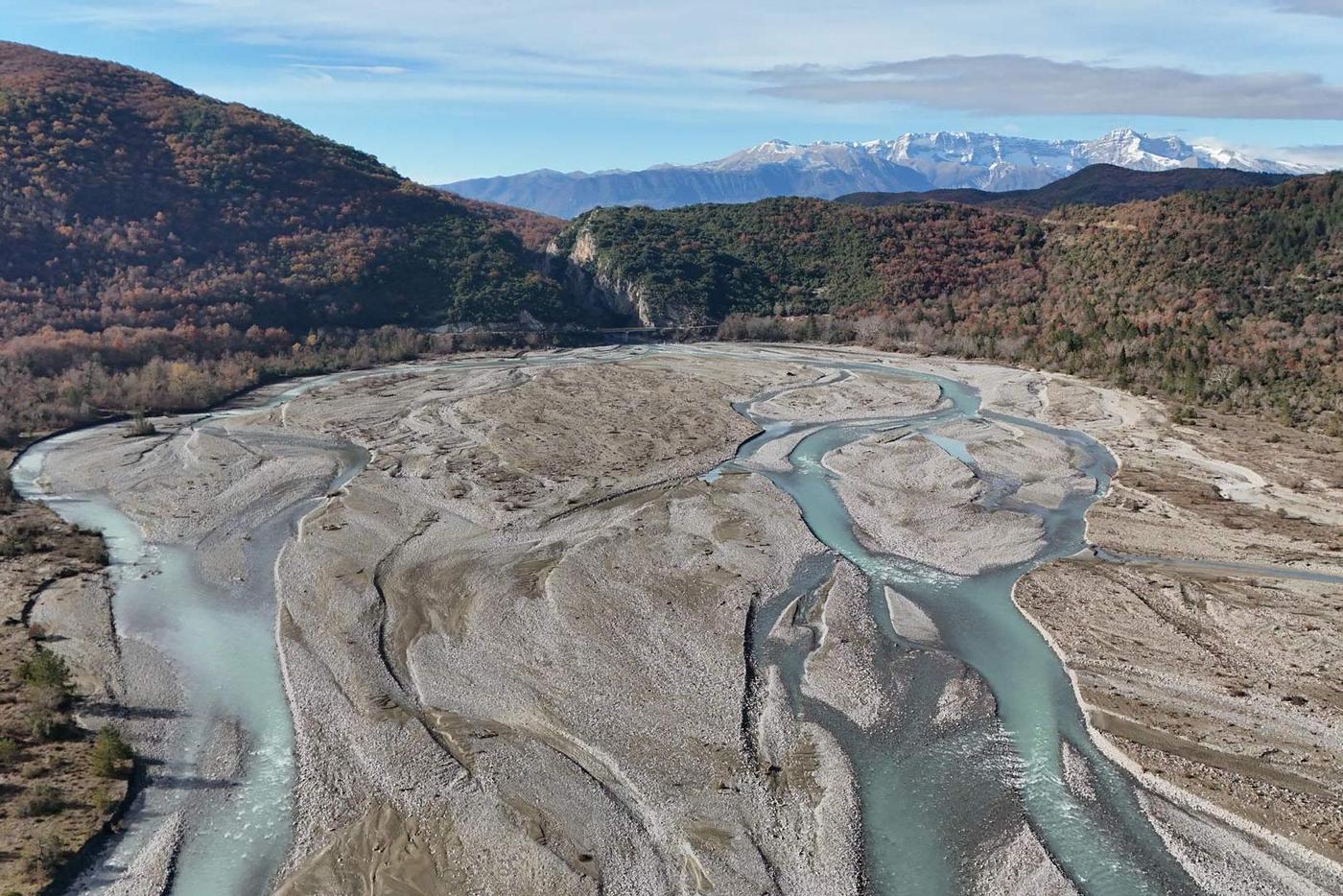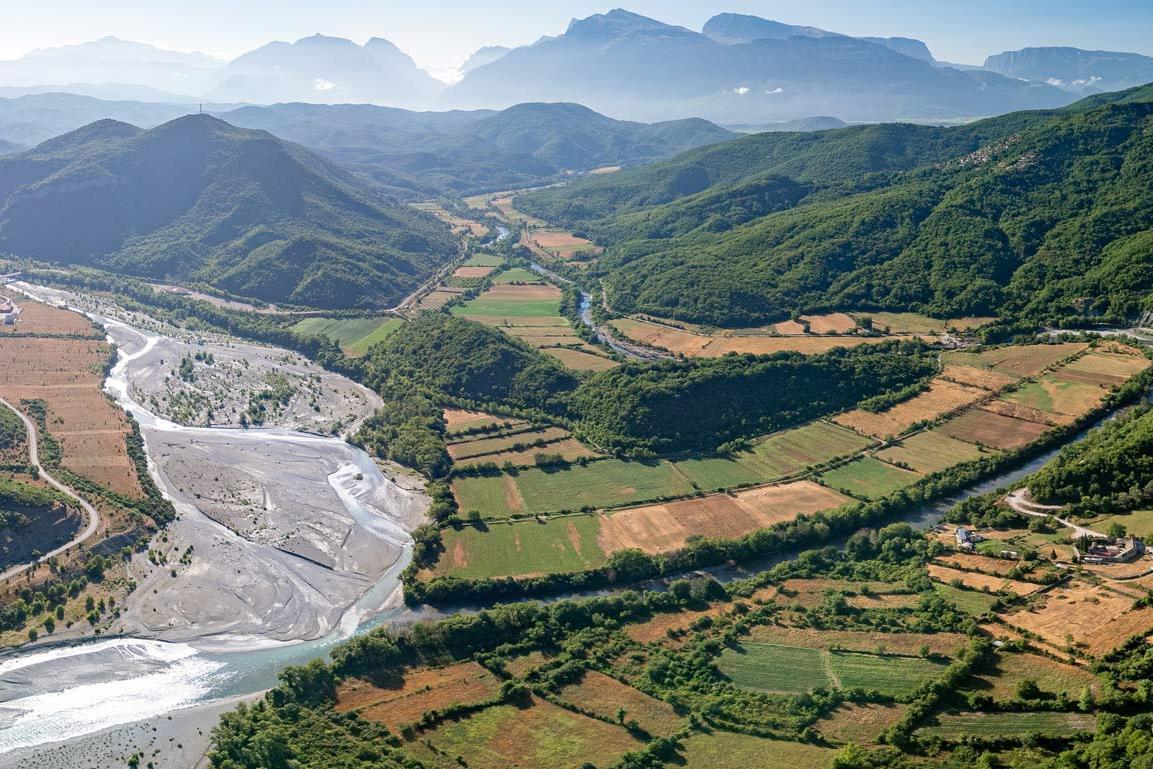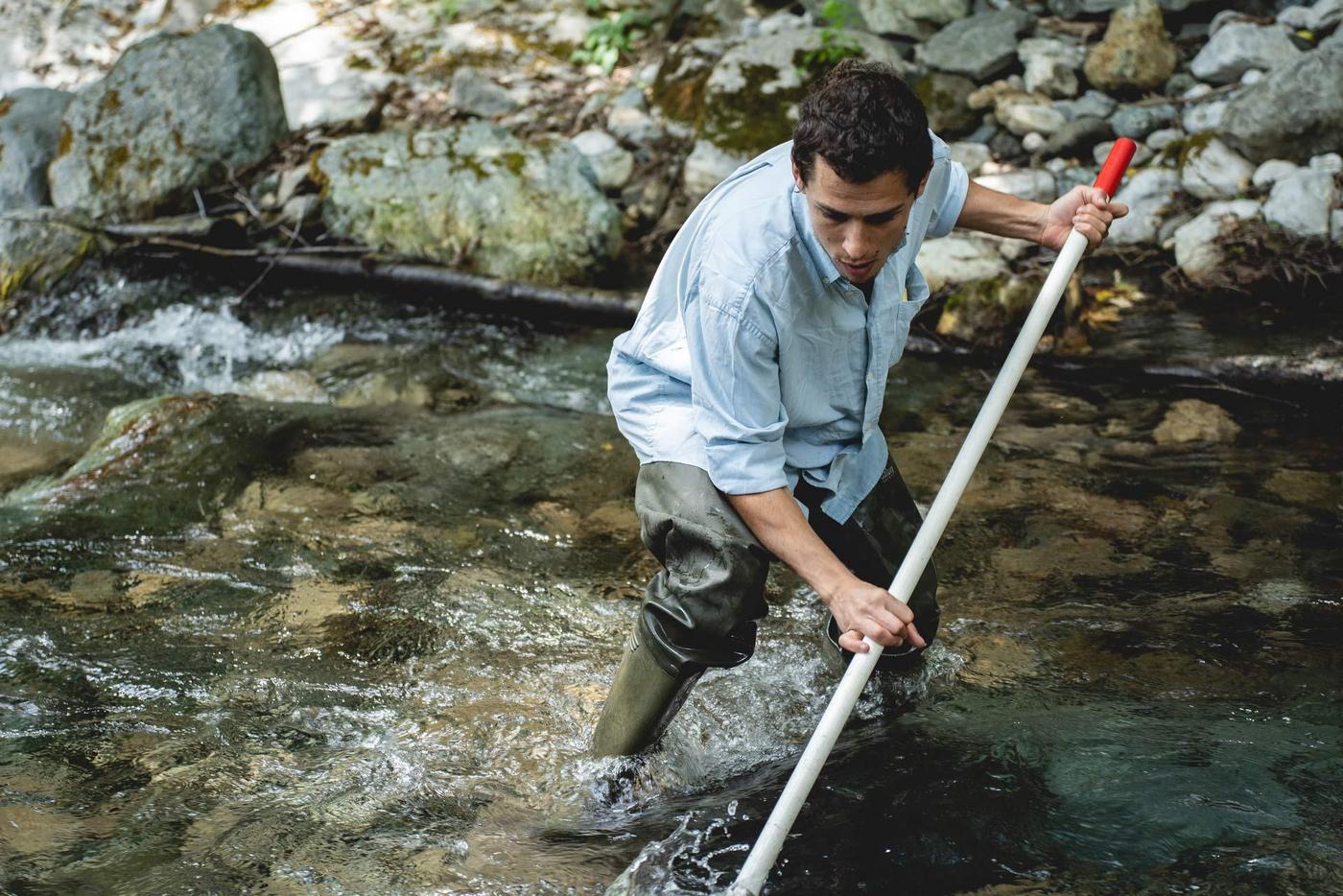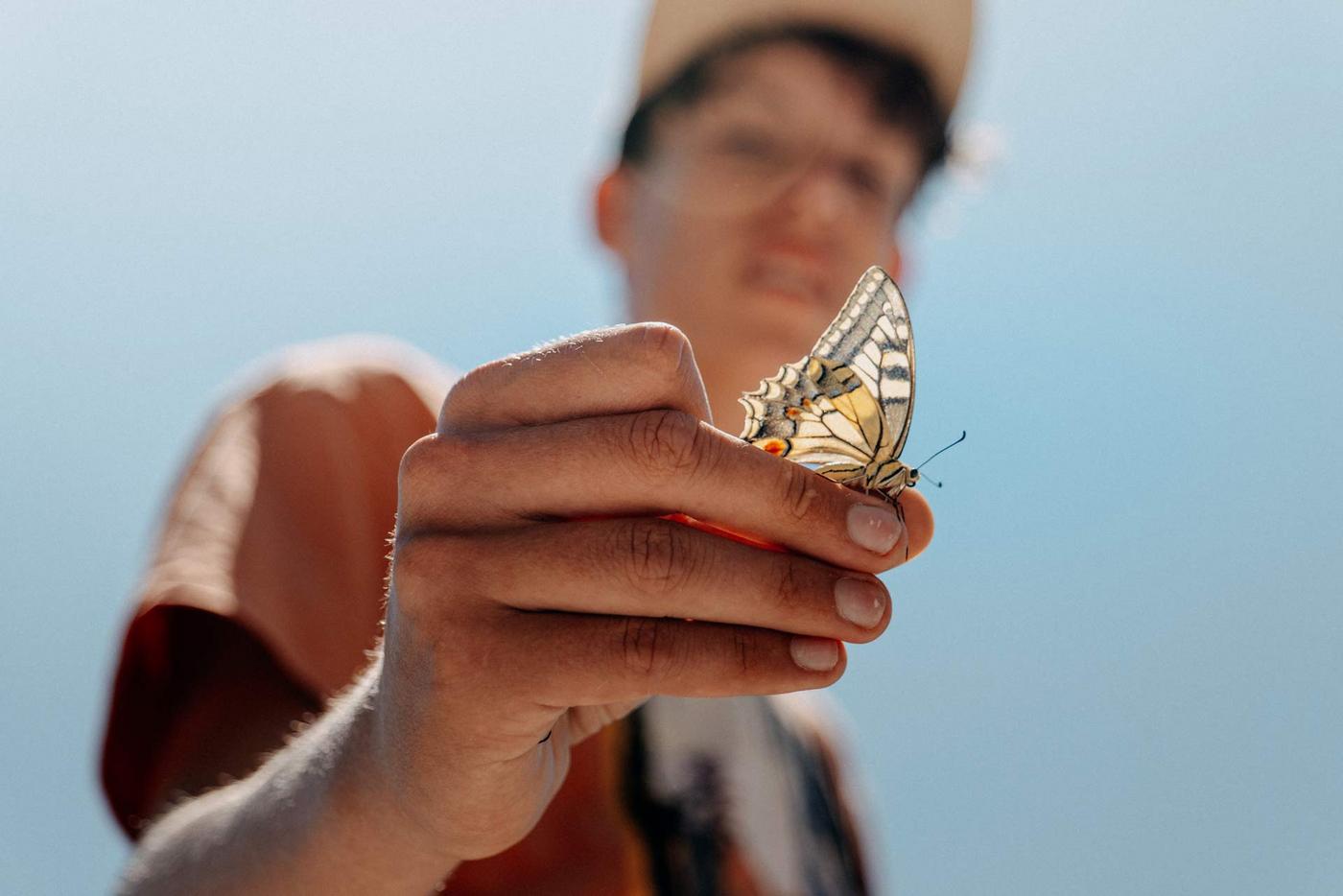“Rivers have the power of bringing people together.”

It is impossible to predict how the Sarantaporos will shape its bed tomorrow. The living conditions for plants and animals change constantly and rapidly with the water level and the course of the river.
© Dimitris PapageorgiouRivers know no borders and they create connections across borders. This is no empty phrase. At least that’s what Fanourios-Nikolaos Sakellarakis, called “Fanikos,” experiences time and again. When he encountered the Sarantaporos for the first time in 2017, he was still working as a field ecologist in the tri-border region between Greece, North Macedonia and Albania. The diversity of the Prespa area fascinated him and also the concept of cross-border conservation. Fanikos had never met a river like this before – so wild, powerful and free. Together with an international, continually growing group of people, the young Greek does not only fight for the protection of the Sarantaporos, but also for the crossborder protection of Aoos/Vjosa as a Wild River National Park of which the Sarantaporos shall be a part (see info bubble on p. xy). What delights Fanikos Sakellarakis most is observing a paradigm shift in the local population’s behaviour – a positive trend giving hope.
Vjosa and Aoos: on the way to a cross-border national park

On the Greek side of the border, the Vjosa is known as the Aoos. Albania can already be seen on the horizon - a man-made border that plays no role for the river itself.
© Joshua David LimFanikos Sakellarakis is standing on one of the historical stone bridges built of the material the Sarantaporos hauls here by water power. “I was 25 years old and drove across the Spiliotopoulou bridge. Then I saw the riverbed!,” he remembers today. “I couldn’t believe how broad it was. I caught my breath and the thought flashed through my mind that this was one of the wildest places I’d ever seen in Greece. Through my work as a field ecologist, I had already seen a lot. Looking back today, that encounter was a key event for me. I really understood the dynamics and power of a pristine river.” A few years on, Fanikos Sakellarakis is conservation coordinator of the Mediterranean Institute for Nature and Anthropos (MedINA) and leads the programme for the protection of freshwater ecoystems.
-
Sarantaporos, Vjosa, Aoos or what?
Eely border crossers

When Fanikos Sakellarakis caught Balkan trout and eels in the upper reaches of the Sarantaporos, his heart beat faster. Naturally, he then released the rare species.
© Aris GiannoukosThe 29th of June 2024 is another eye-opener for him. The whole week had already been extraordinary. Later Fanikos will say that a decisive change began in those days. The science week – organised by MedINA in collaboration with EuroNatur, Riverwatch and EcoAlbania – was part of the initiative “Save the Blue Heart of Europe.” More than 60 researchers from 11 countries came together on a voluntary basis to close knowledge gaps about the Sarantaporos ecosystem and to improve the grounds for its protection.
Together with EuroNatur project lead Leonard Sonten and writer Julian Hoffman, Fanikos accompanied a group of fish experts. They were wading through the rapids when it happened: “An eel moved like lightning across a thin film of water over stones, vanishing so swiftly back into the river that for a moment it felt like it had never been in the net at all,” Julian Hoffman describes it. The direct encounter with an eel in the upper reaches of a river at a distance of almost 200 kilometres from the sea made Fanikos Sakellarakis realise once again the responsibility for cross-border thinking and action, because there is hardly a better symbol for this than the eel. “The eel crossed that invisible line that is the border with Greece and flashed upriver against the quickening current along the Sarantaporos, passing the beautiful stone settlements of the Mastorochoria. The famous stonemasons of these villages once travelled throughout the Balkans. The elegant arched bridge of Kousioumpli is a reminder that human cultures and the lives of wild species have long been entwined,” writes Julian Hoffman, who is currently working on a book about the Aoos/Vjosa river system called River Song. It is not for nothing that MedINA views nature and culture explicitly as two sides of the same coin and it is not for nothing that Vassilis Nitsiakos, historian and professor for social ethnology at the University of Ioannina, warns: “The river Aoos does not only connect two countries. It is one single ecosystem. If it is destroyed, not only a piece of culture is lost, but also a national, even collective memory.”
-
The eel: a symbol of connection
We are seeing a fantastic momentum!

The Greek community of Konitsa on the Aoos
© Aris GiannoukosFanikos Sakellarakis, however, is optimistic. “We are noticing a paradigm shift in locals’ behaviour at the moment. The science week has had a strong effect.” The Sarantoporos’ watershed is located in one of the least populated regions of Greece. Before the Second World War, the villages still had a few thousand inhabitants, today there are perhaps around 20. But many people still feel a connection to their old home, even if they have long since moved to larger towns. The science week made these people realise that an international community is interested in the fate of their river, they have felt seen and taken seriously. In the months since the event, this news has spread like wildfire. “Many have asked us for results, wanted to know which species have been found. Our partner NGOs in the local communities report that they have been successfully mobilising people who had remained on the sidelines thus far. They have now understood the dangers inherent in the hydropower plans,” Fanikos recounts. Just two years ago, merely one or two people spoke up together with the NGOs in the municipality of Konitsa against the permit for a small hydropower plant. When new protests were recently scheduled against a new project, 17 municipal committees issued a joint press relase. “People are motivated when we support them at the political level in calling for the integrity of their river. A great power arises from this, a power continuing to grow. It is a great success for us and feels really good to see the seeds sprouting which we have jointly sown. These seeds are many years of public relations work in the communities and also with the young people.”
Too much is at stake

Fanikos illustrates what the destruction of the Aoos’ unique riverscape would mean for biodiversity by another fish encounter during the science week. “We were standing in the coldest water I ever experienced, surrounded by floodplain forests and breathtaking mountain scenery. In only half an hour, we netted more than 25 Balkan trouts of the species Salmo farioides,” he recounts and adds with a smile: “which we of course set free directly afterwards.” The species is strictly protected at national as well as at European level and is not found anywhere else in the Sarantaporos in such density. “A hydropower plant, however, is to be built right there. It would destroy everything on which the biodiversity of this place thrives. With the results of the science week and together with the locals we will spare no efforts to prevent a construction permit. If we achieve our great aim of the Greek and Albanian governments establishing a cross-border Wild River National park Aoos/Vjosa, it will be a milestone. But after that, it will take hundreds of more steps until this ecosystem is also protected in practice and in the field.”
He only knows too well how particularly difficult it is in the Balkans to realise transnational projects. Especially the different conservation practices, legislations and political structures are challenging. Things are not made easier by one country already being in the European Union and the other not – as in the case of Greece and Albania. “I see how much our EcoAlbania partners are interested in collaborating, and we are also cooperating with organisations like EuroNatur and Riverwatch which support us at European level. This network gives me confidence!”




